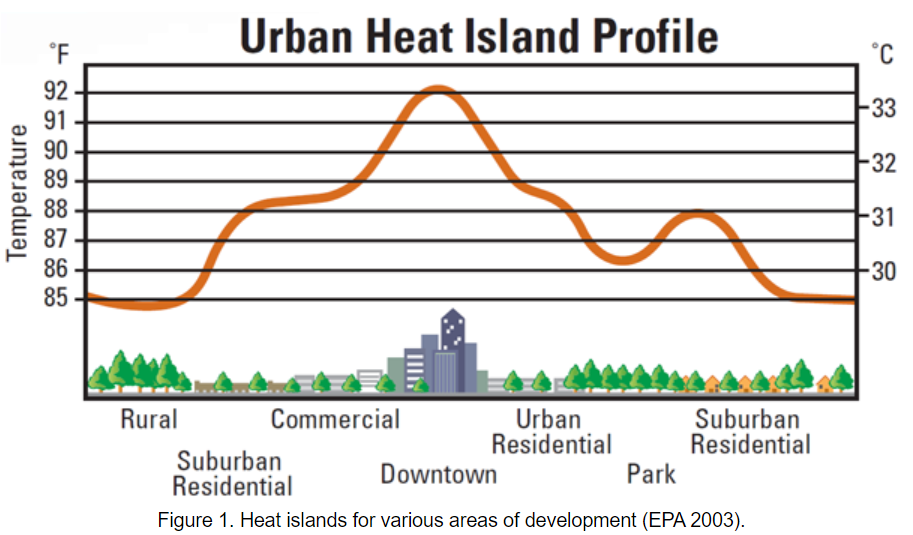Heat From Asphalt and How to Reduce It
- Taisia Osipova

- Aug 16, 2021
- 3 min read

When walking around Philadelphia during the summer, it is easy to notice how hot it is outside, not just from the sun itself, but also from the asphalt reflecting the sunlight, creating even more heat. While I was in the suburbs, I noticed the same effect, but only from the large empty parking lots around shopping centers, and not around my neighborhood. Sunlight is not the only factor that affects the temperature of asphalt. Other elements such as wind and even evaporation and surface water (mostly in relation to fully pervious pavement) can influence the heat of the asphalt. As mentioned before, cities have more asphalt, as well as tall buildings which reflect sunlight, all of which contributes to what is called an urban heat island. The measure of reflectivity of a material, or albedo, is an important factor of a pavement’s ability to reflect sunlight, as well as it’s thickness and color of paint.


Over time, the ability of concrete to reflect solar energy will decrease, while the ability of asphalt to reflect solar energy will increase. This is something that civil engineers should consider when planning for a long term project where the pavement would not be replaced for several years.
The effects of this heat from asphalt include burn injuries (for both animals and humans) because if you look at hot pavement or asphalt at two o'clock in the afternoon in direct sunlight, the temperature is usually somewhere around 170 to 180 degrees Fahrenheit. In addition to causing burn injuries, on days when it gets really hot, and the temperature of asphalt can reach around 140 degrees Fahrenheit, it releases harmful aerosol particles that can transform into air pollutant particles known as PM2.5 that can be harmful when inhaled into the atmosphere. This creates almost as much pollution as the cars driving on the road. (Lugo)
So how do we reduce this heat effect? One solution is to not paint the asphalt black, and also to use different materials such as concrete or grass paving, which is basically any structure that provides load bearing strength while protecting vegetation root systems from deadly compaction by cars, all while decreasing heat island effect. However, these alternatives may not be popular for a while due to their costs being higher than asphalt, as well as the volume of pavement that would have to be replaced, especially in and around cities. (Pavements)
Another solution is to install a photovoltaic pavement like the one installed in Barcelona back in April. The scalability and reliability of the system is going to be assessed after six months, and “If we’re going to reach a target of zero emissions, we’re going to have to think about supplying electricity to blocks of flats, but we’ll also have to think of using wind and solar parks outside the city,” Badia says, who is responsible for climate emergency and ecological transition at Barcelona city council. “But installations on the ground like this open up new possibilities, and not just for Barcelona.” The Barcelona scheme follows the installation of a 25-metre stretch of solar cycle lane in the Dutch city of Utrecht last year. The electricity generated is used to power lighting and also heat the path in winter to prevent it from icing over. Due to the large area of the United States, there may be even more potential to generate renewable energy from pavements in the cities as well as from solar and wind farms outside of cities, similarly to Barcelona. (Burgen)
It is crucial that we begin to think about these solutions not just for the overall safety of our planet and the environment, but also to prevent health hazards such as burns, both for ourselves and our pets and other animals. Think about this the next time you are driving down the road on a really hot day or walking near a place with a lot of asphalt, such as an empty parking lot.
Sources
Burgen, S. (2021, April 29). Barcelona installs Spain's first solar energy pavement. The Guardian. https://www.theguardian.com/environment/2021/apr/29/barcelona-installs-spains-first-solar-energy-pavement
Finding ways to cool the temperature of asphalt. For Construction Pros. (2017, June 12). https://www.forconstructionpros.com/asphalt/article/12320046/finding-ways-to-cool-the-temperature-of-asphalt.
Lugo, D. (2020, September 9). On hot Days, ASPHALT can release as much air pollution as cars. Smithsonian.com. https://www.smithsonianmag.com/smart-news/hot-days-asphalt-may-release-much-air-pollution-cars-180975756/.
Pavements. U.S. Department of Transportation/Federal Highway Administration. (n.d.). https://www.fhwa.dot.gov/pavement/sustainability/articles/pavement_thermal.cfm.
Press, T. A. (2021, June 15). Doctors warn of burns from asphalt as a record-breaking heat wave envelops the west. NPR. https://www.npr.org/2021/06/15/1006588868/doctors-warn-of-burns-from-asphalt-as-a-record-breaking-heat-wave-envelopes-the-.







I've never felt so wanted and spoiled as when I was with one of the Escorts Saket. - Saket Escorts, you're my favorite!